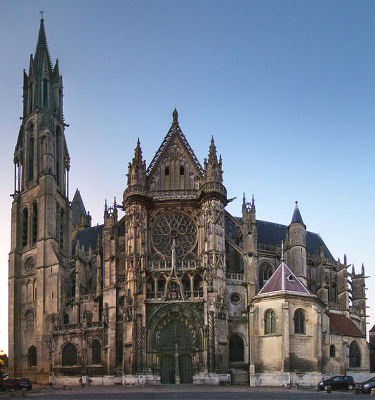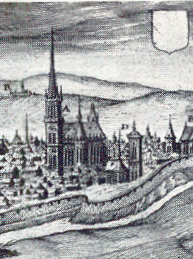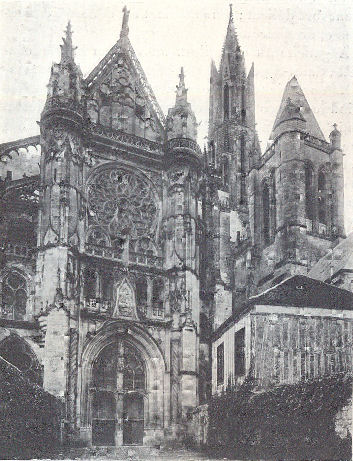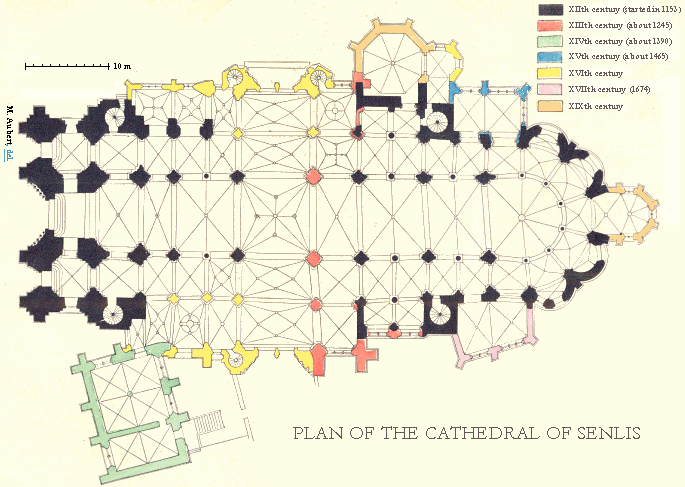
South facade of Senlis cathedral
[see also section
on perspective in Arras cathedral page]
construction
history
This history is typical for gothic cathedrals - building
progress depends on the funds available at any one time,
and that progress is often diverted by fires, fashion
and civil strife.
| date |
Financing |
Events,
work done |
Fires |
| 1153 |
Louis
VII |
Reconstruction
started of previous church fallen in ruins |
|
| 1168 |
Louis VII made a
new donation |
|
|
| 1180 |
|
Choir
finished |
|
| 1184 |
|
Cathedral
almost finished |
|
| 1196 |
Chapter becomes
rich from donations |
Construction
and decoration continues. |
|
| 1st half 13th century |
Many donations of
lands, jewels, silver from kings, bishops, powerful
lords |
|
|
| by 1238 |
|
Tapestries
and silk cloths covered the walls from the grand entrance
to the master altar. Other items included an organ
and thirty candelabra. |
|
| 1240 |
|
radical
change
Central spans removed, pillars shifted a bit, and
built the transept. Tower added to south bell tower. |
|
| 1342 |
1/4 or 1/6th of
diocese revenues to be applied to repairs. |
Construction
finished, start of maintenance period. |
|
| end
14th century |
|
Capitular
room and library built to the south [in green
on plan] |
|
| 1417 |
|
|
Fire in the roof
space melted lead roofing and badly effected belfry
and bell tower, vaults remained intact. |
| 1465 |
|
large
chapel of Saint-Jacques or of Bailli [in blue
on plan], to north of choir |
|
| June 1504 |
|
|
radical
change
Fire started by lightning set ablaze wooden roof structure,
the belfry and high parts of the cathedral. Central
nave vaults collapsed, spire threatened. Lead flowed
in the streets, the fire burning for two days. |
| 1505 |
Donations
from “rich and generous inhabitants”. |
Bell
tower and spire consolidated, belfry re-established,
bells installed. Lantern above transept crossing and
choir tribunes shored up. |
|
| 1507 |
Salt tax, raising
1,200 pounds annually for six years, and extended
further.. |
|
|
| 1506-1515 |
|
West
walls of transepts built, and the turrets at their
extremities, then the chapels on south side, large
windows of choir and nave. |
|
| 1513-1515 |
|
Much
roofing replaced in lead, small tower roofed in slate. |
|
| Furnishing
and decoration continued at the same time as construction: |
| 1515 |
|
Stained
glass of high windows. |
|
| 1517 |
|
Five
windows at end of choir replaced by painted glass
showing the history of Mary. |
|
| January 1519 |
|
Master
altar blessed. Soon after, the altar was covered by
a great dais supported by four antique columns. |
|
| 1520 |
|
Painter
Jacques Charles decorated dais with gold and azure
blue.
First stone laid on south transept facade. |
|
| September 1524 |
|
Stalls
finished. |
|
| December 1528 |
|
Furnishing
of choir finished. |
|
| 1532 |
|
Rood screen decorated
with gold, and its figures painted. |
|
| 1534 |
|
Organ redone. Transept
vaulting finished, as was the west rose, as well as
lead and slate roofing. |
|
| 1536 |
|
Four bells cast
and placed in north tower. |
|
| 1560 |
|
North transept portal
finished. |
|
| All
these works had entirely changed the cathedral’s
appearance. Although, at least in the lower parts,
the interior looked like a 12th century construction,
most of the exterior had all the characteristics of
the flamboyant style. |
| 1751 |
|
radical
change
13th century porch of central doorway demolished. |
|
| 1758-1765 |
|
Major repair works
done. When these did not obliterate sufficiently traces
of the fires and restorations .... |
|
| 1777 |
|
radical
change
... an Italian, Dominique
Borrani, was commissioned to whitewash the entire
cathedral. |
|
| 1787 |
The
quotation drawn up was for 51,400 pounds, but the
cost ended up as 65,000 pounds, which was only paid
off after the Revolution. |
radical
change
Interior reworked in “18th century taste”:
metal grills to the choir and ambulatory entrances;
marble decoration put on the floor, around pillars,
on the master altar, and on chapels to each side of
choir; a balastrade closed the sanctuary; high wood
stalls on side of the choir.[4] |
|
| 1789-1799 |
French
Revolution, petering out in the later years. |
| 1791 |
|
radical
change
Chosen as the premises for warehousing relics, reliquaries,
sacred vases, paintings, sculptures taken from other
disused churches. |
|
| 1793 |
|
radical
change
Grills removed, doorways mutilated, all paving stones
removed,the stalls, chairs, the organ case were removed
and sold.
Later, the building was used as a Revolutionary meeting
house and for balls and public entertainments, then
an army silage store.
Rubbish heaped on the floor, stained glass smashed,
roof in a bad state. |
|
30 May 1795
[11
prairial an III] |
|
Decree to stop the profanities. Silage taken to a neighbouring
church, and the keys returned to the Catholics.
A grand cleaning and restoration started. |
|
| 1837 |
Notre-Dame
classified as historic monument |
| 1845-1846 |
|
Despite
being an historic monument, sculptor Robinet enthusiastically
replaced the heads and many other details of the west
doorway that had much suffered during the Revolution. |
|
| 1847-1848 |
|
a chapel
to the Virgin, highly decorated with paintings by
Bruslé, replaced the smaller axial apsidal
chapel. |
|
| 1865-1867 |
|
High
windows replaced; rose window tracery replaced, which
lifted balustrades on south facade; sacristy restored. |
|
| |
Donations |
used
to restore the old capitular room, sacristy and several
chapels, to add furniture, to replace wood altars
with ones in stone. |
|
Senlis, being behind the front lines, appears to have
been unaffected by the two world wars (to be confirmed).
| Background
facts |
Senlis  |
- approximate population : 16,000
average altitude/elevation : 75 m
- (ranging from 47m to 140m)
-
-
- cathedral dimensions
- exterior length : 76 m
interior length : 70 m
nave width : 28.5 m
height under vaults : 23.5 m
|

end
notes
- Construction
started on Saint-Denis in 1122, on Noyon Cathedral in
1140, and on Senlis Cathedral in 1153.
- del.
- Del. following the name of the draughtsman is
an abbreviation for the Latin word delineavit,
he drew.
- Although the words ‘bell’ and ‘belfry’ seem related, the bel- portion of belfry
was not connected with bells until comparatively recently.
The word ‘belfry’ goes back to a prehistoric
Common Germanic compound. The second part of the compound
is the element *frij-, meaning “peace,
safety”; while the first element is either *bergan,
meaning “to protect”, giving a compound
meaning of “a defensive place of shelter”,
or *berg-, meaning “a high place”,
and giving a compound meaning of “a high place
of safety, a tower”.
The Old French word derived from the Common Germanic
compound is berfrei. First this meant “siege
tower”, and later “watchtower”. Warning
bells were used in these towers, thus the word was also
applied to bell towers.
In Old North French, berfrei mutated to belfroi. This, in turn, caused English speakers
to think of the native Old English word belle (Modern English, bell), and in Middle English
became belfry meaning “bell tower”.
- Dominique
Borrani similarly whitewashed Chartres cathedral, the
Abbey of Saint-Denis, Saint-Eustache de Paris and Saint-Maclou
de Pontoise, altogether a right little vandal.
- By 1915,
some may say fortunately, hardly any of this decoration
remained except the statue of the virgin Mary by Miotte.
- Translation
of
Law of 11 Prairial [May 30, 1795] Order of the Board
Regarding the restitution of churches - 11 Prairial
(May 30, 1795)
Over a period of several months the churches for all
will be reopened in a manner more or less accepted and
controlled [...].
Article 1 : “Citizens of municipalities and
parts of municipalities of the Republic have provisionally
free use of buildings not destroyed, that were originally
used for the activities of one of religious groups
[cultes]. The buildings can be used under
the supervision of the constituted authorities, both
for meetings ordered by law and for religious activities”.
Article 2 : “The buildings are returned for
use by citizens in their current state, usually empty
and dilapidated, the citizens having the responsibility
to maintain or repair the building.
“If several different religious groups laid
claim to the same place, then it should be used communally,
the most suitable days and hours for each group being
fixed by the municipality.”
But the generosity of the
Convention had its demands and downsides:
Article 5 : “No-one can fulfil the ministry
of any religion in the said buildings, unless he is
awarded the deed before the municipality of the place
where he wants to practise, submitting to the laws
of the Republic. The religious ministers who contravene
this present article, and the citizens who have been
called or admitted therein, will be punished by a
thousand pounds fine, through a police court.” Bulletin of Acts, No. 878
The priests who, during the
French Revolution, refused to swear allegiance to
the Civil Constitution of clergy, would continue to
avoid these acts of submission, which were contrary
to their idea of the Church and to their conscience.
Original:
Loi du 11 prairial an III [30 mai 1795] arrêté
du directoire
Au sujet de la restitution des églises
- 11 prairial (30 mai 1795),
Période de quelques mois réouverture
des églises par tous – de manière
plus ou moins admise et contrôlée, mais
arrêt à nouveau avec le Directoire.
L'article 1er : « Les citoyens
des communes et sections de communes de la République
auront provisoirement le libre usage des édifices
non aliénés destinés originairement
à l'exercice d'un on de plusieurs cultes. Ils
pourront s'en servir sous la surveillance des autorités
constituées tant pour les assemblées
ordonnées par la loi que pour l'exercice de
leur culte. »
L'article 2 : « Ces édifices
étaient remis, à l'usage des citoyens
dans l'état où ils se trouvaient, c'est-à-dire
vides et ordinairement délabrés, à
la charge de les entretenir ou réparer.
« Si des citoyens de la même
commune exerçant des cultes différents
ou prétendus tels, réclamaient concurremment
l'usage du même local, ce local devait leur
être commun et les municipalités, auraient
à fixer pour chaque culte les jours et heures
les plus convenables. »
Mais cette générosité
de la Convention a ses exigences et son revers :
L'art. 5 « Nul ne pourra remplir le ministère
d'aucun culte dans les-dits édifices à
moins qu'il ne se soit fait décerner acte,
devant la municipalité du lieu où il
voudra exercer, de sa soumission aux lois de la République.
Les ministres des cultes qui auront contrevenu au
présent article, et les citoyens qui les auront
appelés ou admis, seront punis chacun de mille
livres d'amende, par voie de police correctionnelle.
» Bulletin des Lois, n° 878.
Le prêtres réfractaires
continueront de se soustraire à ces actes de
soumission, contraires à leur conception de
l’Eglise et à leur conscience.
|
advertising disclaimer |
















![West facade of Senlis cathedral [image probably circa 1915] West facade of Senlis cathedral [image probably circa 1915]](/france/culture/senlis/senlis_west_facade.png)



